(This Retrospective article was published in the July 2006 issue of Rider.)
When the Norton Atlas 750 appeared in 1962, it looked pretty much like the Norton 650.
About the only thing the Atlas had going for it was the bigger engine, but Joe Berliner had figured that cubic inches sold motorcycles as well as they did cars. “Give me a bigger engine, a nice 45 cubic inches,” he told the marketing types in Birmingham, England. “We don’t need no stinkin’ tach, ’cause my boys want midrange power, none of this redline nonsense.” In his ads Berliner liked to refer to this as the High Torque engine, and in truth it was a pretty good stump puller.
I can imagine Edward Turner, originator of the ubiquitous British vertical twin, hearing about the new Norton 750 and muttering from his office over at BSA, “I told you so.” That would refer to Turner’s infamous dictum uttered back in the early 1950s, that a parallel twin should never exceed 650cc and 6,500 rpm, otherwise the vibration would be disastrous.
Remember, those were pushrod days, well before anybody had thought much about overhead camshafts and internal balancers. But Berliner did have his customers figured out; they wanted to whack that throttle at about 3,000 rpm and move out smartly. Any café racer type could buy a 650 Manxman, with twin carbs, a tachometer and low bars, but real American men wanted the Atlas.
The company founded by James L. Norton had come a long way in 60 years. He began building motorized bicycles in 1902, followed by V-twin models, and then a series of exceptional side-valve, OHV and OHC singles. Mr. Norton died in 1925, just as his singles were hitting their stride on the racing circuit. Following World War II Norton was one of the first to jump on Turner’s vertical-twin bandwagon, with the Model 7 Dominator in the popular half-liter class. This particular design put the single camshaft up forward of the cylinders, spun by a chain driven via the right-side timing case; later the chain would be replaced by gears.
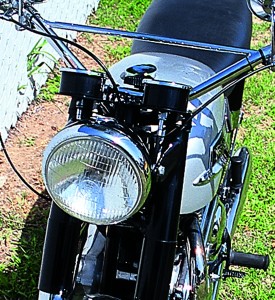
Here we will take a moment to look at enlargement technology. The 497cc Model 7 had a modestly undersquare engine, with a bore of 66mm, stroke, 72.6mm, and the 500 twins stayed true to that until the last 88SS rolled off the line in 1966. In 1956 the 600 models (actually displacing 596cc) showed up, with the bore increased to 68mm, the stroke to 82mm. In 1960 the first 650 appeared, which was really an all-new engine from the crankcases on up, that kept the 68mm bore and increased the stroke to 89mm. Then came the 750 Atlas, based directly on the 650, with the bore enlarged to 73mm and the stroke retaining its 89mm. These were all relatively long-stroke engines, the theory being that this would help keep the revs down, as high rpm was where all those vibratory problems really came about.
The biggest differences between the 650 Manxman—a name insisted on by Berliner, although Norton had never raced a twin at the Isle of Man—and the Atlas was that the latter had but one Amal Monobloc carburetor and a modest 7.6:1 compression ratio, while the Manxman had two carbs and an 8.9:1 ratio. When Berliner gave test bikes to the magazines, he “estimated” the Atlas horsepower to be around 56, while he advertised the 650 Manxman as having 52 at 6,800 rpm. The Brits, disingenuously, gave them both 49.
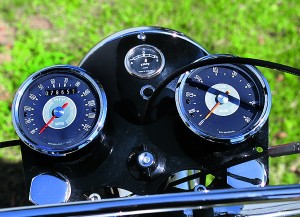
The Atlas used Norton’s famous Slimline Featherbed frame, Slimline referring to the width between the backbone tubes, as opposed to the earlier Wideline. The Featherbed was really two complete tubular loops with four cross pieces providing suitable rigidity and joined at the steering head. The Roadholder fork was suitably famous, though the Girling shocks at back were on the common side. The full-width single-leading-shoe drum brakes were standard for the day, which means they were barely adequate when hauling this 400-pound machine to a stop.
The electrics were a curiosity. Norton stuck with a Lucas magneto for firing the plugs, and a 6-volt Lucas alternator to keep the lights on—pretty old-fashioned for 1962.
The look was essentially Dominator, with mildly valanced fenders, large mufflers, a biggish 4-gallon gas tank and speedometer built into the headlight housing. The bar was slightly raised, as Americans preferred those to the flat bar that was found on the Manxman.
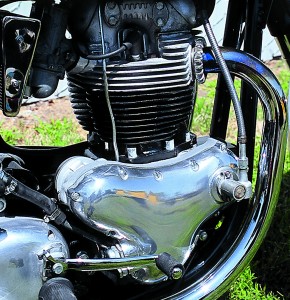
At Berliner’s urging a year later the factory saw fit to bolt a pair of 30mm Monoblocs on the cylinder head. This was a selling point rather than practical. That second carb only really mattered at very close to maximum revs, and the Atlas shook like a paint mixer at anything over 5,000 rpm. The factory also cleaned up the headlight look and gave the instruments a racier appearance by attaching a separate speedo and tach to the steering head. The alternator was given 12 volts, which made the headlight a good deal more useful at night.
In 1963 major changes had been made in the Norton company. Back in 1952 it had become part of Associated Motor Cycles, which produced the Matchless and AJS marques, but the entities remained entirely separate. Ten years later motorcycle sales in the United Kingdom were way too low for a comfortable bottom line, and Norton was moved to London’s Plumstead district—home to Matchless/AJS—to combine the two operations. However, the British motorcycle economy was going from bad to worse, and in 1966 AMC was merged with the BSA/Triumph group. The R&D types at Plumstead had a cost-saving notion—although the factory could not afford to develop a new engine, a new frame was possible, and thus the Commando idea was born in early 1967. This meant the Atlas would have to soldier on until the new design was ready.
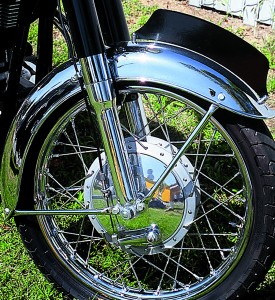
Berliner’s American operation was selling lots of these Atlas models. He also wanted some desert sleds, but the Featherbed frame was just not cut out for off-road work. So for 1967 the Atlas engine was bolted into a Matchless scrambler frame to create the P11 and Ranger models. The Atlas model itself stayed the same, except for a hump at the end of the long seat to give a racy look.
The first Commandos rolled off the production line in the spring of 1968. The Atlas model continued to be built until the stock of parts was depleted. It was a good bike, so long as the rider stayed under 5,000 rpm.
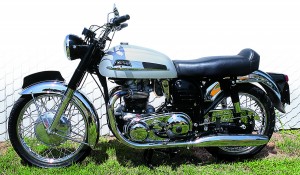








Norton twin camshaft drives were never by gears, always chains. Norton raced a 500cc twin on the Isle of Man, it still remains the only 500cc pushrod engine twin to lap at over 100mph (just) with the late Tom Phillis in I believe 1961, it is all in the record books.
Best regards Ken Frewin (UK) Norton OWNER.
The 650 cc Manxman had high bars in the American market! The crankcases of all the 650s were changed too, with a bulge @ the rear to accommodate the larger stroke crankshaft & big-end assembly, because from the 596 cc engine only had a stroke of 82 mm whereas the 650 engine had as is rightly stated, the 89 mm stroke, so 88, 99 Dominator , crankcases cannot be used on the larger than 596 cc engines.
I have a Commando 750 1969, and I am rebuilding an Atlas about 1964. I can’t wait to see how they handle in comparison.
The engine is really nice with plenty of torque.